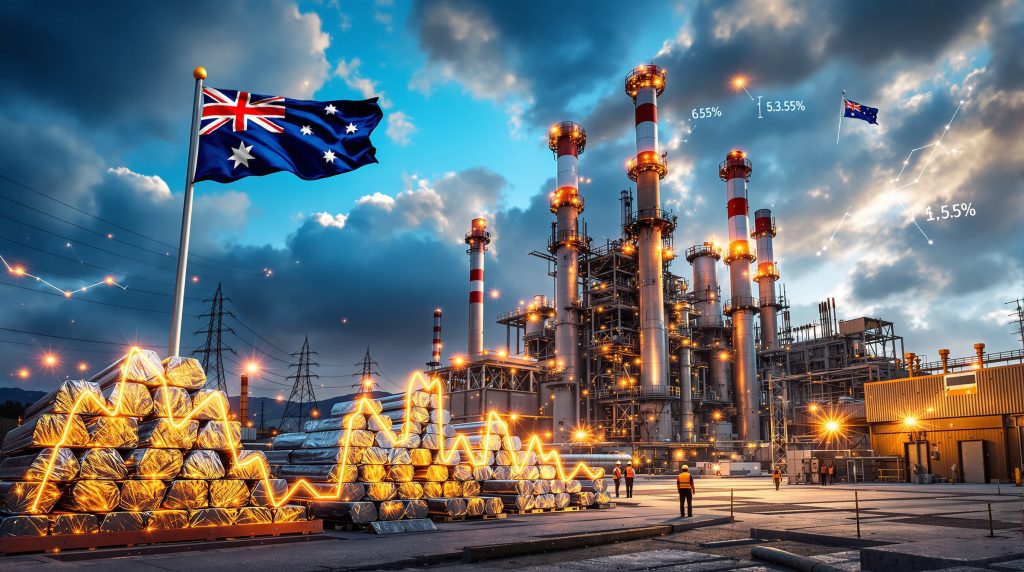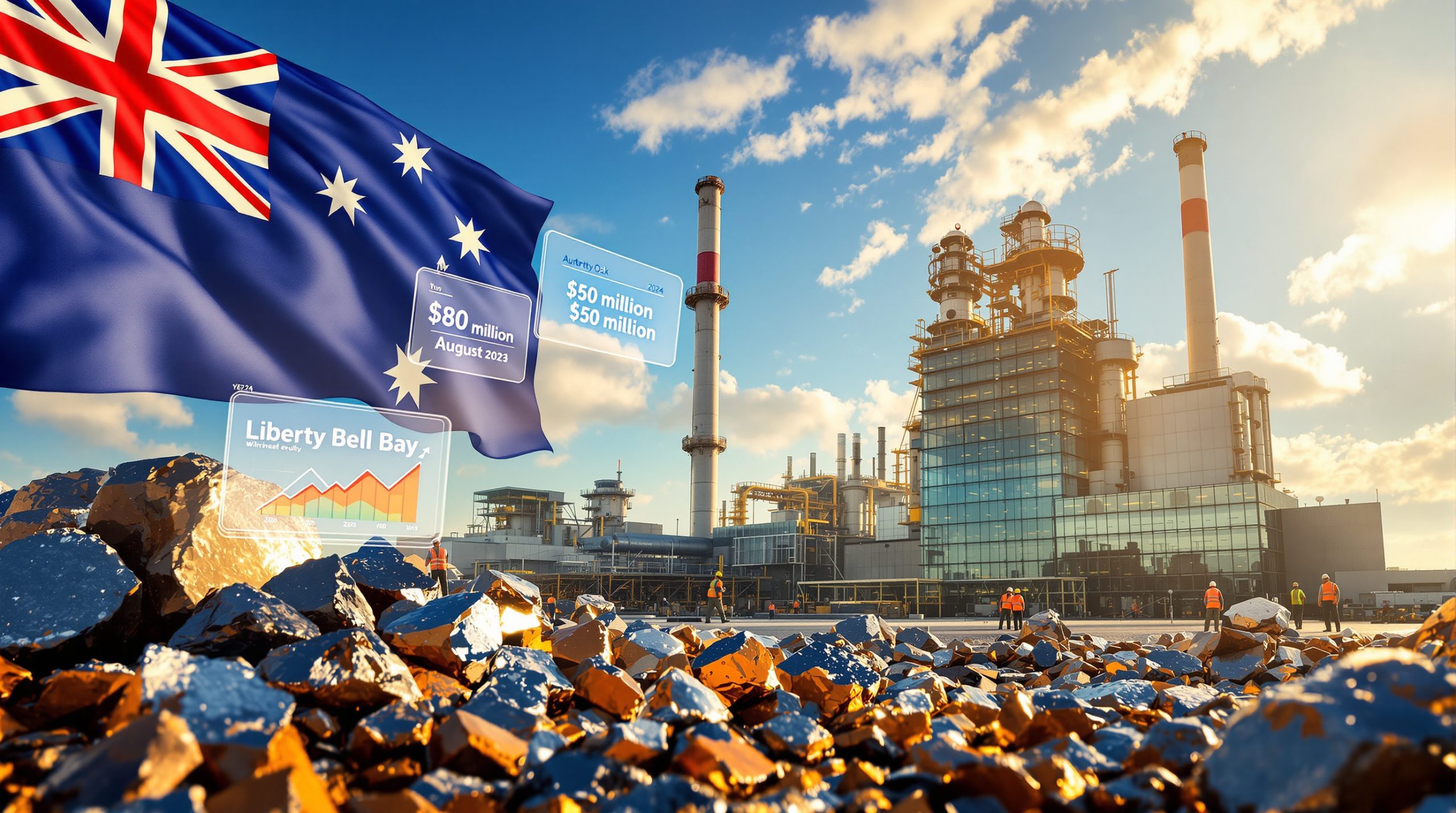Why Are Energy Costs Threatening Rio Tinto's Smelting Operations?
The Rio Tinto aluminium smelter closure risk has escalated dramatically as Australia's energy crisis creates unsustainable operating conditions for industrial facilities. Furthermore, the combination of soaring electricity prices and expiring power contracts threatens the viability of the nation's largest aluminium production capacity.
The Economics of Energy-Intensive Aluminium Production
Australia's aluminium smelting industry faces an unprecedented energy cost crisis that threatens the viability of major production facilities. The fundamental economics of primary aluminium production create a perfect storm when energy prices surge beyond sustainable levels.
Modern aluminium smelters using Hall-Héroult technology consume approximately 13-15 MWh per tonne of aluminium produced, making them among the most energy-intensive industrial operations globally. This massive power requirement stems from the electrolytic process needed to extract aluminium from alumina, operating continuously at temperatures exceeding 900°C.
Energy costs typically represent 30-40% of total production costs in smelting operations, creating extreme vulnerability to electricity price fluctuations. When power costs escalate dramatically, profit margins compress rapidly, forcing operators to reassess facility viability.
The scale of energy consumption becomes clear when examining Tomago smelter's specifications. This facility consumes 850MW of continuous power, equivalent to approximately 12% of New South Wales' total electricity generation capacity. To contextualize this demand, Tomago's power consumption could supply between 600,000-800,000 residential households.
| Cost Component | Percentage of Total Costs | Vulnerability Level |
|---|---|---|
| Energy | 30-40% | Extremely High |
| Raw Materials | 25-35% | Moderate |
| Labour | 8-12% | Low |
| Maintenance | 5-8% | Low |
The continuous power requirement creates additional complexity. Unlike manufacturing facilities that can operate intermittently, primary aluminium smelters require uninterrupted electricity supply. Power interruptions cause irreversible damage to electrolytic cells (potlines), making reliability as critical as pricing.
Contract Expiration Timeline Creating Urgency
Rio Tinto faces a ticking clock with its Australian smelting operations. Tomago's electricity supply agreement terminates at the end of 2028, creating a defined decision deadline that amplifies negotiation pressure.
The company has been actively seeking viable energy solutions since 2022, representing more than three years of unsuccessful negotiations. This extended timeline without resolution suggests fundamental misalignment between Rio Tinto's economic requirements and available market offerings.
Bell Bay smelter faces even more immediate pressure, with its power supply contract expiring in late 2025. This imminent deadline leaves minimal time for complex energy agreement negotiations, increasing closure risk substantially.
Government intervention attempts have included support packages from both federal and NSW governments, yet no agreements have materialised. Industry Minister Tim Ayres confirmed ongoing efforts to secure new power purchasing agreements, stating the government remains focused on exhausting every opportunity to support Tomago operations.
How Do Market Conditions Amplify Closure Risks?
Aluminium Price Volatility vs Fixed Energy Costs
The fundamental challenge facing Rio Tinto's Australian smelters lies in the asymmetric relationship between volatile aluminium prices and increasingly fixed energy costs. This dynamic creates a profitability squeeze that threatens operational sustainability.
Global aluminium prices fluctuate based on supply-demand dynamics, macroeconomic conditions, and trade policies. However, energy contracts for industrial facilities typically involve long-term agreements with fixed or semi-fixed pricing structures. When aluminium prices decline while energy costs remain elevated, operating margins compress rapidly.
Australian smelters face particular competitive disadvantages compared to international producers in regions with structural cost advantages:
• Norway: Abundant hydroelectric power with 70-80% renewable energy at historically low rates
• Canada: Long-term hydroelectric contracts and government support programs
• Middle East: Government-subsidised energy from natural gas reserves
• China: Cost-competitive coal power mixed with expanding hydroelectric capacity
Rio Tinto's statement that it has been unable to find solutions supporting sustainable operations since beginning negotiations in 2022 indicates that even during periods of reasonable aluminium prices, Australian energy cost levels remain economically unsustainable.
Strategic Portfolio Rationalisation
Rio Tinto's approach reflects broader strategic focus on higher-margin, lower-cost operations globally. The company prioritises capital allocation toward mining ventures with superior profitability profiles rather than maintaining energy-intensive processing facilities in high-cost jurisdictions.
This portfolio optimisation strategy involves maintaining only economically sustainable assets while divesting or closing operations that cannot generate adequate returns. The Australian smelting operations appear to fall into the latter category under current market conditions.
The combined capacity of both threatened facilities represents 790,000 tonnes annually (Tomago: 600,000 tonnes, Bell Bay: 190,000 tonnes), making these potential closures significant from both Rio Tinto's portfolio perspective and Australia's industrial capacity. Additionally, this situation highlights broader challenges facing sustainable mining transformation across the industry.
What Role Do Government Interventions Play?
Federal and State Support Mechanisms
Australian governments at multiple levels have recognised the strategic importance of maintaining domestic aluminium smelting capacity. Their intervention attempts demonstrate the economic and employment implications of potential facility closures.
The federal government established A$2 billion low-carbon aluminium production tax credits as part of broader industry support initiatives. Tasmania's government specifically called for applying these credits to Bell Bay smelter support, recognising the facility's renewable energy advantage through hydroelectric power.
Industry Minister Tim Ayres confirmed that Australian federal and NSW governments continue working with Rio Tinto on supporting Tomago operations. His statement about being "very focused on exhausting every opportunity to secure new power purchasing agreements" suggests ongoing negotiations without definitive resolution.
The complexity of government intervention involves coordination between three separate jurisdictions:
• Federal government: Tax credit programs and national industrial policy
• NSW state government: Regional economic development and electricity market regulation
• Tasmania government: State-level support and Hydro Tasmania negotiations
Policy Framework Challenges
Government support mechanisms face inherent challenges in addressing the fundamental economics of high-cost energy supply to industrial users. While renewable energy transition remains necessary for emissions reduction, the transition creates near-term cost pressures through several mechanisms.
Grid Integration Costs: Variable renewable output requires reserve capacity investment, battery storage deployment, and transmission infrastructure upgrades, all reflected in wholesale electricity pricing.
Balancing Service Requirements: Intermittent renewable generation necessitates grid stability investments including frequency regulation and voltage support systems.
Capacity Factor Impacts: Renewable energy deployment reduces capacity factors of existing generation assets, increasing unit costs for dispatchable power sources.
The fact that government support packages have been offered but agreements remain elusive indicates the gap between proposed assistance and Rio Tinto's profitability requirements. Furthermore, government interventions may be insufficient to bridge fundamental cost-competitiveness issues, highlighting the need for comprehensive renewable energy solutions tailored to industrial needs.
Which Specific Facilities Face Immediate Threats?
Tomago Smelter: Australia's Largest at Risk
Tomago represents Australia's largest aluminium smelting operation, with annual capacity of 600,000 tonnes and continuous power consumption of 850MW. This facility's significance extends beyond its production capacity to its role in NSW's electricity grid infrastructure.
The smelter accounts for 12% of NSW's total electricity generation capacity, making its potential closure significant for state-level energy market dynamics. Removal of this continuous baseload demand would require grid rebalancing and potentially affect wholesale electricity pricing mechanisms.
Rio Tinto's three-year search for viable energy solutions without success highlights the severity of cost challenges. Despite government support offers, the company stated it has been unable to find arrangements supporting sustainable operations, indicating proposed solutions fail to meet profitability thresholds.
The 2028 contract expiration creates a defined decision window with approximately 27 months remaining from the October 2025 timeline. Given unsuccessful negotiations spanning multiple years, the compressed timeframe increases urgency for all stakeholders.
Key Tomago Statistics:
• Annual capacity: 600,000 tonnes
• Power consumption: 850MW continuous
• Grid significance: 12% of NSW generation capacity
• Contract deadline: End of 2028
• Negotiation duration: 3+ years without resolution
Bell Bay: Tasmania's Hydroelectric Advantage Insufficient
Bell Bay smelter presents a paradoxical situation where renewable energy advantages fail to ensure economic viability. Despite operating primarily on hydroelectric power, this facility faces immediate closure risk with contracts expiring in late 2025.
The facility's 190,000 tonnes annual capacity represents approximately 24% of the combined threatened Australian smelting capacity. While smaller than Tomago individually, Bell Bay's closure would have significant regional economic impact for Tasmania.
The renewable energy paradox demonstrates that energy source sustainability does not automatically translate to economic sustainability. Hydro Tasmania's pricing policies apparently do not align with smelter profitability requirements, despite the theoretical cost and emissions advantages of hydroelectric power.
Tasmania's request for Commonwealth support through the A$2 billion low-carbon aluminium production tax credits suggests state-level resources are insufficient to bridge the economic gap independently. This scenario exemplifies the complex energy transition challenges facing traditional industrial sectors.
Bell Bay's hydroelectric power advantage illustrates that even renewable-powered production may not survive current market economics, challenging assumptions about sustainable energy providing automatic cost benefits for industrial operations.
The immediate timeline pressure for Bell Bay exceeds Tomago's 2028 deadline, creating higher decision-making urgency as of late 2025.
How Do Energy Market Dynamics Impact Smelter Viability?
Electricity Price Trajectory Analysis
NSW electricity pricing demonstrates the escalating cost pressures facing industrial energy consumers. Spot electricity prices have increased dramatically over the past decade, creating unsustainable operating conditions for energy-intensive industries.
Historical NSW Electricity Price Progression:
• 2014: A$35.17/MWh
• 2023-24: A$101.57/MWh
• 2024-25: A$128.16/MWh
• 10-year increase: 264%
• Year-on-year growth (2024-25): 26.2%
This escalation reflects multiple factors associated with Australia's renewable energy transition. While necessary for emissions reduction, the transition creates immediate cost pressures through renewable energy intermittency and associated grid stability requirements.
The acceleration in price increases becomes apparent when examining recent trends. The A$26.59/MWh increase from 2023-24 to 2024-25 represents a 26.2% annual escalation, demonstrating the rapid pace of cost growth facing industrial electricity consumers.
| Year | Price (A$/MWh) | Annual Change (%) | Cumulative Increase (%) |
|---|---|---|---|
| 2014 | 35.17 | – | – |
| 2023-24 | 101.57 | – | 189% |
| 2024-25 | 128.16 | 26.2% | 264% |
International Electricity Cost Comparison
Australian industrial electricity costs rank among the highest globally, reflecting several structural factors that disadvantage domestic manufacturing. Geographic isolation limits interconnection with other power markets, preventing arbitrage opportunities and price moderation through regional competition.
Grid transformation costs associated with the transition from centralised coal generation to distributed renewable sources require substantial transmission infrastructure investment, reflected in wholesale pricing. Additionally, relatively small industrial electricity demand compared to regions with large manufacturing sectors reduces economies of scale for industrial power contracts.
Countries maintaining competitive industrial electricity costs include Norway and Canada (abundant hydroelectric resources), and France (nuclear baseload generation), highlighting Australia's disadvantageous position for energy-intensive industries.
Power Purchase Agreement Challenges
Primary aluminium smelters require 20+ year power agreements for operational certainty, reflecting typical capital intensity and operational planning requirements spanning decades. This creates fundamental misalignment with energy market preferences for shorter-term, more flexible arrangements.
Energy providers demonstrate reluctance to offer fixed-price long-term contracts due to uncertainty about future electricity costs. Renewable deployment pace, technology cost trajectories, and grid integration requirements create risk exposure for suppliers committing to extended fixed-price agreements.
Risk Allocation Challenges:
• Fixed-price contracts: Suppliers bear inflation and cost escalation risk
• Variable/indexed contracts: Customers bear price increase risk
• Hybrid structures: Attempt to share risk through collar agreements or escalation formulas
Rio Tinto's inability to reach agreement despite government support packages indicates the gap between smelter requirements (fixed 20+ year pricing) and market offerings (shorter terms or variable pricing) remains unresolved. Consequently, the broader energy transition in mining faces similar challenges across industrial sectors.
Grid integration costs add complexity, requiring additional infrastructure investments for reliable industrial supply including dedicated transmission upgrades, grid stability services, and backup capacity arrangements.
What Are the Broader Industry Implications?
Australian Aluminium Sector Transformation
The potential closure of both Tomago and Bell Bay smelters would fundamentally reshape Australia's aluminium industry landscape. Combined annual capacity loss of 790,000+ tonnes represents a significant reduction in domestic production capability.
Supply Chain Disruption: Downstream manufacturing operations dependent on domestic aluminium supply would face sourcing challenges, potentially requiring international imports or supply chain restructuring.
Skills Migration: Specialised workforce expertise in primary aluminium production could migrate to other industries or regions, eroding Australia's technical capabilities in this sector.
Regional Economic Impact: Both facilities represent major employers and economic anchors for their respective regions, with closure implications extending beyond direct employment to local supply chains and service providers.
Global Aluminium Market Effects
Australian production cuts could contribute to global supply-demand rebalancing, particularly affecting regional trade flows and pricing dynamics. The removal of 790,000 tonnes from global supply could create opportunities for producers in lower-cost regions.
Production Shift Dynamics:
• Other countries potentially benefiting from Australian capacity reduction
• Investment redirection toward lower-cost production regions
• Supply chain reconfiguration as end-users adjust sourcing strategies
This capacity reduction would represent a notable shift in global aluminium production geography, potentially strengthening the competitive position of smelters in regions with sustainable energy cost advantages. Moreover, these developments underscore the importance of mining decarbonisation benefits in maintaining competitive positions globally.
Can Alternative Energy Solutions Provide Salvation?
Renewable Energy Integration Possibilities
Australia possesses abundant renewable energy resources that could theoretically support industrial energy requirements. However, the challenge lies in developing infrastructure capable of providing continuous, reliable power supply at commercially viable rates.
Solar and Wind Potential: Australia's renewable energy resources are among the world's best, with high solar irradiance and consistent wind patterns in many regions suitable for large-scale development.
Storage Technology Requirements: Industrial facilities requiring continuous power supply need battery storage or pumped hydro capacity to manage renewable energy intermittency. These storage solutions currently add substantial cost to renewable energy projects.
Infrastructure Development Timeline: The timeframe for developing renewable energy infrastructure with adequate storage capacity may not align with Rio Tinto's contract expiration deadlines, particularly the 2025 Bell Bay timeline.
Hydrogen Production Pivot Potential
Smelter sites could potentially transition to green hydrogen production facilities, leveraging existing electrical connections and industrial zoning advantages. This alternative use could preserve some economic value from existing infrastructure investments.
Infrastructure Reuse Advantages:
• High-voltage electrical connections already established
• Industrial zoning approvals in place
• Skilled workforce potentially transferable
• Port access for hydrogen export (applicable to coastal facilities)
However, hydrogen market development timing may not align with immediate closure pressures. Global hydrogen demand growth remains in early stages, with commercial viability depending on market maturation and international trade infrastructure development.
What Strategic Options Remain for Rio Tinto?
Operational Restructuring Scenarios
Several operational modifications could potentially extend facility viability while reducing energy costs and operational complexity.
Partial Capacity Reduction: Operating selected potlines rather than complete facility closure could reduce total energy consumption while maintaining some production capability. This approach would require careful evaluation of fixed cost absorption across reduced capacity.
Seasonal Operation Models: Running smelters during periods of lower electricity costs could improve economics, though the continuous operation requirements of aluminium smelting technology limit flexibility for intermittent operations.
Technology Upgrade Investments: Improving energy efficiency through modernisation could reduce per-tonne power consumption, though such investments require substantial capital deployment with uncertain payback periods given current energy cost trajectories.
Partnership and Divestment Alternatives
Alternative ownership or partnership structures could potentially change operational economics and risk tolerance for continued operations.
Joint Venture Possibilities: Sharing operational costs and risks with other industry participants could improve project economics, particularly if partners have different cost structures or risk appetites.
Government Equity Participation: Public-private partnership models could enable strategic asset retention with shared investment in infrastructure upgrades or energy cost subsidisation.
Asset Sale Considerations: Transferring ownership to operators with different cost structures, risk profiles, or strategic priorities could provide alternatives to closure.
The success of these alternatives depends on identifying counterparties with different operational economics or strategic objectives that make continued operation viable under current market conditions. Nevertheless, the Rio Tinto aluminium smelter closure risk remains elevated given the fundamental challenges facing energy-intensive industries in Australia's evolving electricity market.
The Tomago aluminium smelter faces potential closure as Rio Tinto continues negotiations with energy providers and government stakeholders. Additionally, Rio Tinto confirms consultation regarding Tomago's future operations, indicating the urgency of finding viable solutions for Australia's largest aluminium production facility.
Disclaimer: This analysis is based on publicly available information and market observations. Forward-looking statements regarding facility closures, government interventions, and market conditions involve inherent uncertainties and should not be considered as investment advice or definitive predictions of future outcomes.
Looking to Capitalise on Market Shifts in Industrial Commodities?
Discovery Alert's proprietary Discovery IQ model delivers real-time alerts on significant aluminium and industrial commodity discoveries across the ASX, empowering subscribers to identify actionable opportunities as market dynamics shift. Begin your 30-day free trial today to position yourself ahead of the market as Australia's industrial landscape continues evolving.




